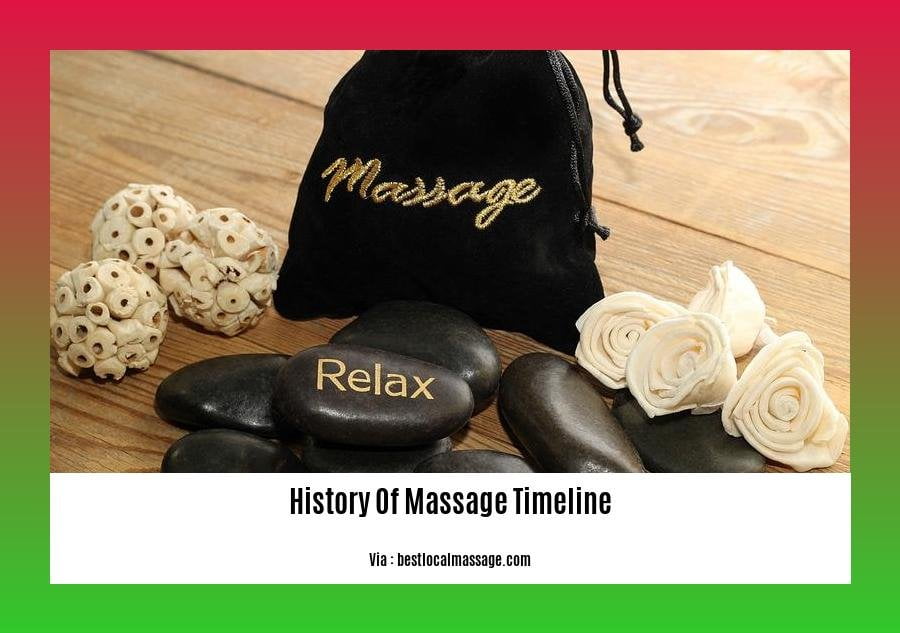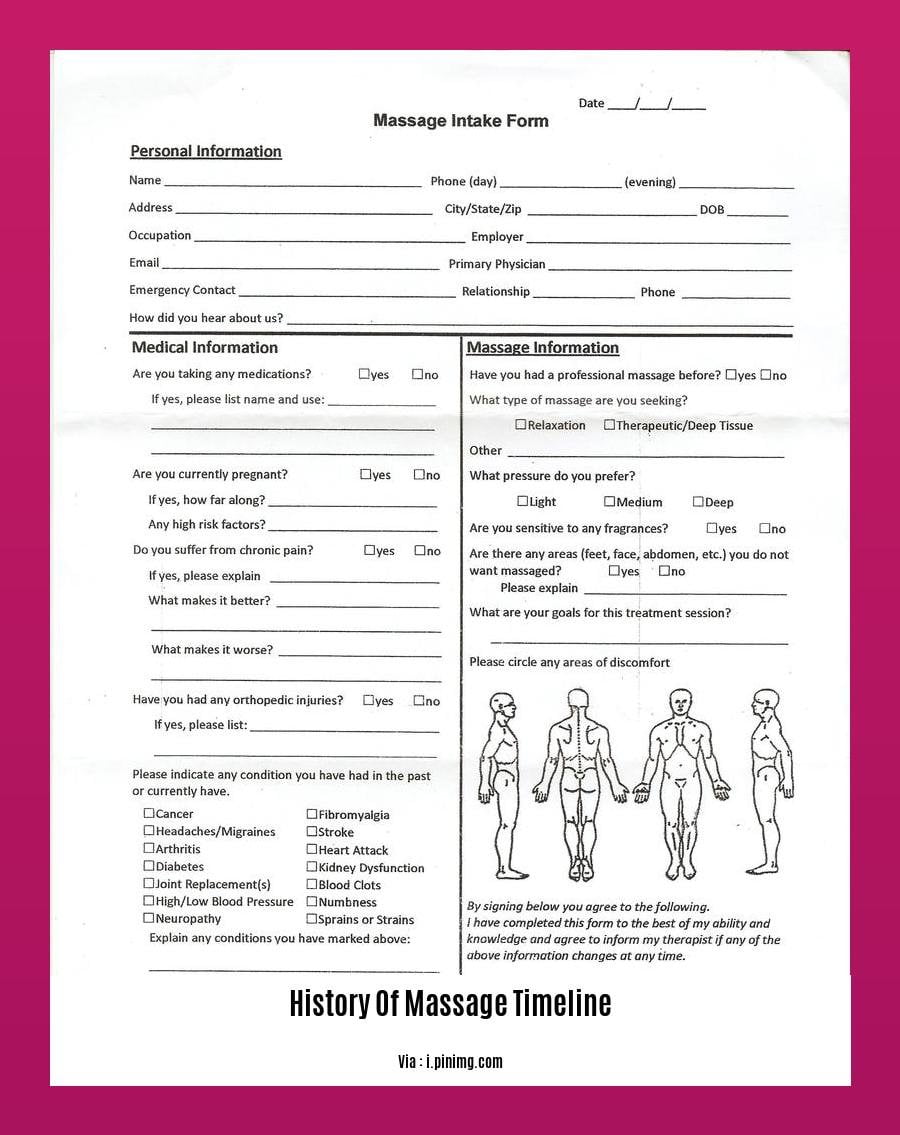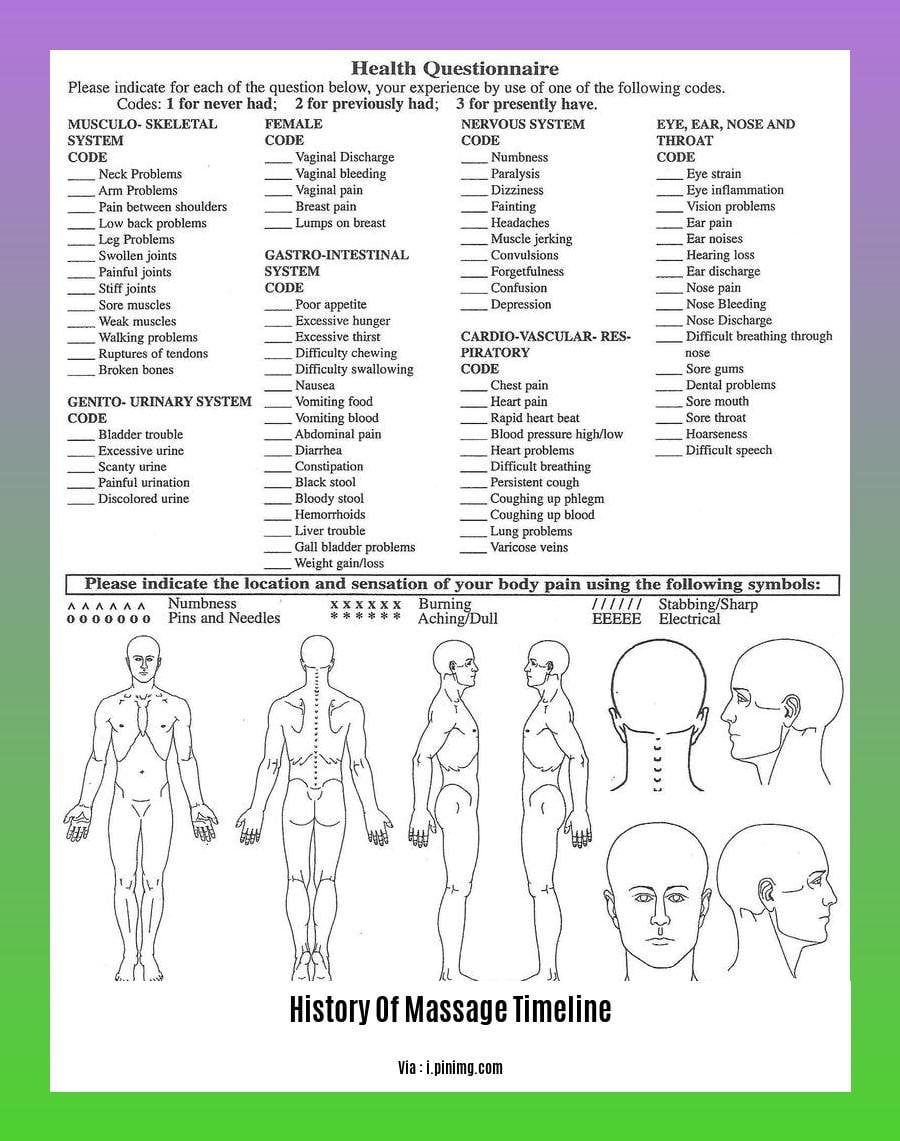Throughout history, the art of massage has evolved into a diverse and profound practice that transcends time and culture. Embark on a journey through the annals of massage, discovering the ancient origins, cultural influences, and scientific advancements that have shaped this therapeutic practice. From the healing hands of ancient civilizations to the modern marvels of massage therapy, explore the remarkable evolution of this age-old tradition in [A Journey Through Time: Exploring the History of Massage Timeline].
Key Takeaways:
Massage therapy has a long and rich history spanning over 5,000 years.
It originated in ancient China around 2700 BCE and was mentioned in ancient medical texts like the Yellow Emperor’s Classic of Internal Medicine.
Massage was practiced in ancient Egypt for medical, cosmetic, and athletic purposes.
In ancient India, massage was an essential part of Ayurvedic medicine, focusing on overall health and well-being.
Ancient Greece embraced massage for athletes, doctors, and philosophers, with Hippocrates advocating for its use in treating various ailments.
During the Roman Empire, massage flourished in bathhouses, enhancing circulation and promoting relaxation.
Over time, massage therapy has evolved, incorporating techniques and influences from diverse cultures and traditions.
Today, massage therapy is recognized as a valuable complementary and alternative medicine practice with numerous benefits for physical and mental health.
History of Massage Timeline

Massage has a rich and extensive background that spans several millennia, evolving into a widely recognized and respected healing practice. Let’s embark on a journey through time to explore the significant historical milestones of massage therapy:
Ancient Roots:
The history of massage can be traced back to ancient China, where it was documented in medical texts like the Yellow Emperor’s Classic of Internal Medicine around 2700 BC.
In ancient Egypt, massage was used for both medical and cosmetic purposes, and was also employed by athletes to prepare for competitions.
Massage was an integral part of ancient Indian Ayurvedic medicine, as it was believed to promote overall health and well-being.
Legacy of Greece:
Massage was a common practice in ancient Greece, where athletes, doctors, and philosophers alike utilized it.
Hippocrates, the renowned “Father of Medicine,” strongly advocated for massage in treating various ailments.
Roman Bathhouse Rituals:
- During the Roman Empire, massage therapy flourished in bathhouses, where it was widely regarded as a means of enhancing circulation and promoting relaxation.
Evolution and Diversification:
Over the centuries, massage therapy has undergone significant evolution, incorporating diverse techniques and influences from various cultures and traditions.
This amalgamation has led to the development of a wide range of massage modalities, each tailored to specific needs and preferences.
Modern Acceptance:
Today, massage therapy is extensively recognized as a valuable complementary and alternative medicine practice, with a plethora of well-documented benefits for both physical and mental health.
It is commonly integrated into healthcare regimes as a safe and effective means of pain relief, stress reduction, improved circulation, and overall well-being.
Have you ever wondered how martial arts came to be? Explore the rich history of martial arts and trace its evolution across cultures and centuries.
History of Martial ArtsThe streets of Venice have always held secrets behind their masks. Delve into the history of masks in Venice and uncover the stories of intrigue, romance, and artistry that lie beneath each disguise.
History of Masks in Venice
India: 800 B.C. – Ayurvedic texts describe massage as a healing art.
Ayurveda, a medical system rooted in ancient Indian tradition, embraces massage as a fundamental healing practice. The earliest records of massage in India date back to around 800 B.C., when Ayurvedic texts described massage as an essential component of maintaining health and well-being.
Imagine a time when ancient Indian healers, known as Vaidyas, skillfully manipulated muscles, tendons, and joints to alleviate pain, promote relaxation, and restore balance to the body. Massage was considered an indispensable healing factor, integrated into the holistic approach of Ayurveda.
Ayurvedic massage, also known as Abhyanga, is a full-body treatment that employs various techniques to enhance circulation, improve lymphatic drainage, and eliminate toxins from the body. It involves the use of warm, aromatic oils tailored to individual needs, providing a deeply nourishing and rejuvenating experience.
The ancient Indian belief in the power of touch is still prevalent today. Massage plays a vital role in India’s healthcare system, with many seeking its benefits for general wellness, fitness, and minor health ailments.
Key Takeaways:
Ayurveda, an ancient Indian medical system, recognized massage as a crucial therapeutic practice around 800 B.C.
Ayurvedic massage, called Abhyanga, involves full-body manipulation to enhance circulation, promote relaxation, and eliminate toxins.
Warm, aromatic oils are used to enhance the massage experience and provide nourishment to the body.
Massage remains an integral part of India’s healthcare system, with many seeking its benefits for general wellness and specific health concerns.
Source 1: https://www.soulvibrationwellness.com/blog/2023/7/18/the-history-of-massage-part-2-a-journey-to-india
Source 2:
Greece: 5th Century BC Onwards – Hippocrates Referenced Massage as Part of Healthy Living

Ancient Greece, where wisdom flourished, was the birthplace of groundbreaking ideas in medicine and healthcare. This era witnessed the rise of legendary healers, philosophers, and scientists, with Hippocrates standing as the towering figure of medical history.
Hippocrates, the Father of Medicine
Hippocrates, born around 460 BC on the island of Cos, was a revolutionary in the field of medicine. He challenged the prevailing beliefs and practices, advocating for an approach rooted in observation, clinical experience, and a deep understanding of the human body.
Hippocrates’s Four Elements Theory
Hippocrates believed that the human body was composed of four elements- fire, water, earth, and air. He proposed that an imbalance in these elements led to illness or disease. Massage, according to Hippocrates, could help restore the equilibrium and promote healing.
Massage in Hippocratic Medicine
Massage played a pivotal role in Hippocratic medicine. Hippocrates recognized the therapeutic benefits of massage and prescribed it for various ailments, including muscle pain, joint stiffness, and digestive issues. He believed that massage could stimulate blood circulation, improve muscle tone, and alleviate pain.
Hippocrates’s Approach to Patient Care
Hippocrates emphasized the significance of treating the whole person, not just their symptoms. He advocated for a holistic approach to healthcare that considered the physical, mental, and emotional well-being of the patient. Massage, with its ability to promote relaxation and reduce stress, was an integral part of Hippocrates’s holistic approach.
Legacy of Hippocrates
Hippocrates’s teachings and writings, meticulously documented in the Hippocratic Corpus, laid the foundation of Western medicine. His emphasis on observation, holistic care, and the importance of massage as a therapeutic tool continues to influence medical practices even today.
Key Takeaways:
- Hippocrates, the father of Western medicine, lived in ancient Greece in the 5th century BC.
- He developed a theory of four elements, believing that an imbalance led to illness.
- Hippocrates recognized the therapeutic benefits of massage and used it to treat various ailments, considering it essential for overall well-being.
- Hippocrates’s holistic approach to healthcare, encompassing physical, mental, and emotional aspects, made massage an integral part of his medical practice.
- His teachings and writings in the Hippocratic Corpus continue to shape modern medical practices, underscoring the enduring influence of his ideas.
Citations:
- Hippocrates – Biography, Theories, & Influence
- [Hippocrates, Father of Western Medicine](
Europe: Middle Ages – Massage Therapy Declined Due to Association With Paganism
Imagine a time when massage, a practice that today is widely embraced for its therapeutic benefits, faced resistance and decline. The Middle Ages in Europe witnessed such a phenomenon. The prevalent religious beliefs of the era significantly impacted the trajectory of massage therapy, leading to its temporary setback. Let’s delve into this intriguing chapter in the history of massage.
The seeds of massage therapy were planted in ancient civilizations like Egypt, China, and Greece, where it flourished as a revered healing art. However, the arrival of the Middle Ages marked a shift in societal attitudes towards massage. The rise of Christianity, with its strict moral codes, cast a shadow over the practice, which was often associated with pagan rituals and sensual pleasures.
The Church, holding great influence over the lives of people, viewed massage as a threat to its teachings. It condemned the practice as sinful and immoral, fearing it could lead to licentious behavior. Consequently, massage therapy was gradually marginalized and pushed into the shadows.
The decline of massage during the Middle Ages was not just a matter of religious opposition. The prevailing medical theories of the time also played a role. Galenic medicine, based on the ideas of the ancient Greek physician Galen, dominated medical thought in Europe for centuries. This approach emphasized the importance of bloodletting and purging for treating ailments, leaving little room for massage therapy.
Despite the challenges, massage therapy did not completely disappear. It found refuge in the hands of folk healers, midwives, and bathhouse attendants, who continued to practice it in secret. These individuals, often marginalized by the Church, preserved the ancient knowledge and techniques of massage, ensuring its survival through the dark ages.
The legacy of the Middle Ages left an enduring impact on massage therapy. It took centuries for the practice to regain its former glory, eventually emerging as a respected and widely accepted form of healthcare in the Renaissance and beyond.
Key Takeaways:
- Massage therapy has ancient roots, tracing back to various ancient civilizations.
- During the Middle Ages in Europe, massage therapy faced decline due to its association with pagan beliefs and practices.
- The Church’s influence and condemnation of massage as sinful contributed to its marginalization.
- Galenic medicine, the dominant medical theory of the time, focused on bloodletting and purging, leaving little room for massage therapy.
- Folk healers, midwives, and bathhouse attendants kept the practice alive during the Middle Ages, preserving its techniques and knowledge.
Source:
- A Brief History of Massage
- History of Massage Therapy
FAQ
Q1: When and where did massage therapy originate?
A1: Massage therapy has its roots in ancient China around 2700 BC, where it was documented in medical texts like the Yellow Emperor’s Classic of Internal Medicine.
Q2: How was massage therapy used in ancient Egypt?
A2: In ancient Egypt, massage was practiced both for medicinal and cosmetic purposes. Athletes also used it to prepare for competitions.
Q3: What role did massage play in ancient Indian Ayurvedic medicine?
A3: Massage was an integral part of ancient Indian Ayurvedic medicine, where it was used to promote overall health and well-being.
Q4: Who was Hippocrates, and what was his contribution to massage therapy?
A4: Hippocrates, known as the “Father of Medicine,” advocated for the therapeutic benefits of massage in ancient Greece.
Q5: How did massage therapy evolve and spread across different cultures?
A5: Over the centuries, massage therapy evolved and diversified, incorporating techniques and influences from different cultures and traditions. Today, it is recognized as a valuable complementary and alternative medicine practice.














